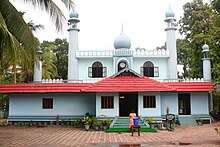Early history of Islam in India

Cheraman Perumal Juma Masjid on the Malabar Coast, probably the first Mosque in India

Jama Masjid, Delhi, one of the largest mosques in the "Asia-Pacific" region.
Trade relations have existed between Arabia and the Indian subcontinent since ancient times. Even in the pre-Islamic era, Arab traders used to visit the Konkan-Gujarat coast and Malabar region, which linked them with the ports of South East Asia. Newly Islamised Arabs were Islam's first contact with India. The historians Elliot and Dowson say in their book The History of India as told by its own Historians, the first ship bearing Muslim travellers was seen on the Indian coast as early as 630 AD. H.G. Rawlinson, in his book: Ancient and Medieval History of India claims the first Arab Muslims settled on the Indian coast in the last part of the 7th century AD. Shaykh Zainuddin Makhdum's "Tuhfat al-Mujahidin" is also a reliable work. This fact is corroborated, by J. Sturrock in his South Kanara and Madras Districts Manuals, and also by Haridas Bhattacharya in Cultural Heritage of India Vol. IV. It was with the advent of Islam that the Arabs became a prominent cultural force in the world. The Arab merchants and traders became the carriers of the new religion and they propagated it wherever they went.
The first Indian mosque, Cheraman Juma Masjid, is thought to have been built in 629 AD by Malik Bin Deenar.
In Malabar, the Mappilas may have been the first community to convert to Islam. Intensive missionary activities were carried out along the coast and many natives also embraced Islam. These new converts were now added to the Mappila community. Thus among the Mappilas, we find, both the descendants of the Arabs through local women and the converts from among the local people.
In the 8th century, the province of Sindh (in present-day Pakistan) was conquered by an Arab army led by Muhammad bin Qasim. Sindh became the easternmost province of the Umayyad Caliphate.
In the first half of the 10th century, Mahmud of Ghazni added the Punjab to the Ghaznavid Empire and conducted 17 raids on modern-day India. In the 11th century, Ghazi Saiyyad Salar Masud played a significant role in the conversion of locals (Hindus) to Islam. A more successful invasion came at the end of the 12th century by Muhammad of Ghor. This eventually led to the formation of the Delhi Sultanate.
Engr Sulthan
| www.keralites.net |
Posted by: "Engr.Sulthan" <er_sulthan@yahoo.com>
| Reply via web post | • | Reply to sender | • | Reply to group | • | Start a New Topic | • | Messages in this topic (1) |
To subscribe send a mail to Keralites-subscribe@yahoogroups.com.
Send your posts to Keralites@yahoogroups.com.
Send your suggestions to Keralites-owner@yahoogroups.com.
To unsubscribe send a mail to Keralites-unsubscribe@yahoogroups.com.
Homepage: http://www.keralites.net




No comments:
Post a Comment